
Employee listening tools gather real-time feedback directly from staff to improve engagement and workplace culture, using surveys, pulse checks, and sentiment analysis. Crowdsourcing platforms harness collective intelligence from a broader audience, including employees, customers, and external stakeholders, to generate innovative ideas and solve complex problems. Explore these strategies to enhance organizational decision-making and employee involvement.
Why it is important
Understanding the difference between employee listening tools and crowdsourcing platforms is crucial for Human Resources to effectively gather targeted feedback and foster innovation. Employee listening tools focus on capturing real-time employee sentiments and engagement through surveys and pulse checks, enhancing workplace culture and retention. Crowdsourcing platforms leverage collective intelligence to generate ideas and solve problems across a broader audience, driving organizational creativity and collaboration. Properly choosing between these tools ensures strategic alignment with HR objectives and maximizes workforce productivity.
Comparison Table
| Feature | Employee Listening Tools | Crowdsourcing Platforms |
|---|---|---|
| Purpose | Capture employee feedback, sentiment, and engagement | Gather ideas and solutions from a broad external or internal crowd |
| Primary Users | HR teams, managers, internal leadership | Organizations, innovation teams, product managers |
| Data Source | Internal employee communications, surveys, sentiment analysis | Large, diverse user groups inside or outside the company |
| Key Benefits | Improves employee engagement, retention, and culture insights | Drives innovation, idea generation, and problem-solving |
| Examples | Glint, Qualtrics EmployeeXM, Culture Amp | IdeaScale, Crowdicity, Innocentive |
| Interaction Type | Two-way feedback, anonymous or identified insights | Open contribution, voting, and collaboration |
| Focus | Employee experience and organizational health | Innovation and collective intelligence |
| Integration | HRIS, communication tools, analytics platforms | APIs, collaboration software, social media channels |
Which is better?
Employee listening tools provide real-time insights into workforce sentiment by analyzing feedback from surveys, performance reviews, and communication channels, enabling HR teams to address issues proactively. Crowdsourcing platforms harness collective intelligence for problem-solving, idea generation, and innovation but may lack the depth of personal employee experience data critical for engagement strategies. For optimizing employee satisfaction and retention, integrating employee listening tools with crowdsourcing platforms offers a comprehensive approach to workforce management.
Connection
Employee listening tools collect real-time feedback and sentiments from staff, providing valuable insights into workplace dynamics. Crowdsourcing platforms harness collective intelligence by engaging employees to contribute ideas and solutions, enhancing innovation and problem-solving. Integrating these technologies empowers HR departments to foster a collaborative culture and make data-driven decisions for improved employee engagement.
Key Terms
Talent Pool
Crowdsourcing platforms harness diverse external talent pools for innovative problem-solving, expanding organizational capabilities beyond internal limits. Employee listening tools concentrate on internal talent, gathering real-time feedback to enhance engagement, retention, and productivity. Explore how leveraging both strategies can optimize your talent pool management.
Feedback Mechanisms
Crowdsourcing platforms leverage diverse external inputs to enhance innovation and problem-solving through collective intelligence, while employee listening tools concentrate on internal feedback to improve workplace culture and employee engagement. Feedback mechanisms in crowdsourcing emphasize scalability and varied perspectives, contrasting with employee listening tools' focus on real-time sentiment analysis and anonymous communication channels. Explore the nuances of these feedback mechanisms to optimize your organization's innovation and employee satisfaction strategies.
Engagement Insights
Crowdsourcing platforms facilitate large-scale idea generation by harnessing diverse employee input, while employee listening tools provide continuous, real-time feedback to gauge engagement levels and sentiment accurately. Insights derived from crowdsourcing highlight innovation trends and collective intelligence, whereas employee listening tools capture engagement pulse and help identify immediate issues affecting morale. Explore deeper differences and tailored applications to maximize workforce engagement effectively.
Source and External Links
Top 5 Crowdsourcing Platforms: A Brief Overview - Amazon Mechanical Turk and Upwork are suited for small tasks and freelance work, while Topcoder and Innocentive specialize in software and scientific challenges respectively, offering platforms to connect businesses with a global workforce for diverse project needs.
Top 10 Data Crowdsourcing Platform in 2025 - Leading data crowdsourcing platforms like LXT and Appen break down large projects into microtasks for global contributors, focusing on AI data collection, annotation, and validation, with LXT noted for its large reliable network and Appen for its user-friendly interface despite some recent performance issues.
We Tested the 10 Best Crowdsourcing Platforms on ... - Wazoku Crowd (formerly InnoCentive) uses a crowd contest model where companies post challenges with cash prizes for solutions from a skilled community, ideal for companies seeking innovative problem-solving through a large established network of experts.
 dowidth.com
dowidth.com